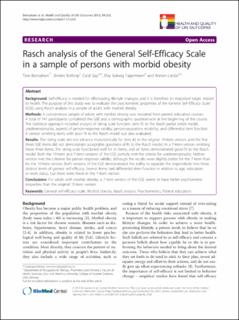Please use this identifier to cite or link to this item:
https://doi.org/10.21256/zhaw-3912Full metadata record
| DC Field | Value | Language |
|---|---|---|
| dc.contributor.author | Bonsaksen, Tore | - |
| dc.contributor.author | Kottorp, Anders | - |
| dc.contributor.author | Gay, Caryl | - |
| dc.contributor.author | Fagermoen, May | - |
| dc.contributor.author | Lerdal, Anners | - |
| dc.date.accessioned | 2018-07-27T12:27:53Z | - |
| dc.date.available | 2018-07-27T12:27:53Z | - |
| dc.date.issued | 2013 | - |
| dc.identifier.issn | 1477-7525 | de_CH |
| dc.identifier.uri | https://digitalcollection.zhaw.ch/handle/11475/8710 | - |
| dc.description.abstract | Background: Self-efficacy is needed for effectuating lifestyle changes, and it is therefore an important target related to health. The purpose of this study was to evaluate the psychometric properties of the General Self-Efficacy Scale (GSE) using Rasch analysis in a sample of adults with morbid obesity. Methods: A convenience sample of adults with morbid obesity was recruited from patient education courses. A total of 141 participants completed the GSE and a demographic questionnaire at the beginning of the course. The statistical approach included analysis of rating scale function, item fit to the Rasch partial credit model, unidimensionality, aspects of person-response validity, person-separation reliability, and differential item function. A version omitting items with poor fit to the Rasch model was also evaluated. Results: The rating scale did not advance monotonically for item #2 in the original 10-item version, and the first three GSE items did not demonstrate acceptable goodness-of-fit to the Rasch model. In a 7-item version omitting these three items, the rating scale functioned well for all items, and all items demonstrated good fit to the Rasch model. Both the 10-item and 7-item versions of the GSE partially met the criteria for unidimensionality. Neither version met the criterion for person response validity, although the results were slightly better for the 7-item than for the 10-item version. Both versions of the GSE demonstrated the ability to separate the respondents into three distinct levels of general self-efficacy. Several items had differential item function in relation to age, education or work status, but there were fewer in the 7-item version. Conclusions: For adults with morbid obesity, a 7-item version of the GSE seems to have better psychometric properties than the original 10-item version. | de_CH |
| dc.language.iso | en | de_CH |
| dc.publisher | BioMed Central | de_CH |
| dc.relation.ispartof | Health and Quality of Life Outcomes | de_CH |
| dc.rights | https://creativecommons.org/licenses/by/2.0/ | de_CH |
| dc.subject | Morbid obesity | de_CH |
| dc.subject | Prospective study | de_CH |
| dc.subject | Psychometrics | de_CH |
| dc.subject | Quality of life | de_CH |
| dc.subject | Self efficacy | de_CH |
| dc.subject.ddc | 616: Innere Medizin und Krankheiten | de_CH |
| dc.title | Rasch analysis of the General Self-Efficacy Scale in a sample of persons with morbid obesity | de_CH |
| dc.type | Beitrag in wissenschaftlicher Zeitschrift | de_CH |
| dcterms.type | Text | de_CH |
| zhaw.departement | Gesundheit | de_CH |
| zhaw.organisationalunit | Institut für Ergotherapie (IER) | de_CH |
| dc.identifier.doi | 10.21256/zhaw-3912 | - |
| dc.identifier.doi | 10.1186/1477-7525-11-202 | de_CH |
| dc.identifier.pmid | 24268204 | de_CH |
| zhaw.funding.eu | No | de_CH |
| zhaw.issue | 202 | de_CH |
| zhaw.originated.zhaw | Yes | de_CH |
| zhaw.publication.status | publishedVersion | de_CH |
| zhaw.volume | 11 | de_CH |
| zhaw.publication.review | Peer review (Publikation) | de_CH |
| Appears in collections: | Publikationen Gesundheit | |
Files in This Item:
| File | Description | Size | Format | |
|---|---|---|---|---|
| 2013_Kottorp_Rasch_analysis.pdf | 490.47 kB | Adobe PDF |  View/Open |
Show simple item record
Bonsaksen, T., Kottorp, A., Gay, C., Fagermoen, M., & Lerdal, A. (2013). Rasch analysis of the General Self-Efficacy Scale in a sample of persons with morbid obesity. Health and Quality of Life Outcomes, 11(202). https://doi.org/10.21256/zhaw-3912
Bonsaksen, T. et al. (2013) ‘Rasch analysis of the General Self-Efficacy Scale in a sample of persons with morbid obesity’, Health and Quality of Life Outcomes, 11(202). Available at: https://doi.org/10.21256/zhaw-3912.
T. Bonsaksen, A. Kottorp, C. Gay, M. Fagermoen, and A. Lerdal, “Rasch analysis of the General Self-Efficacy Scale in a sample of persons with morbid obesity,” Health and Quality of Life Outcomes, vol. 11, no. 202, 2013, doi: 10.21256/zhaw-3912.
BONSAKSEN, Tore, Anders KOTTORP, Caryl GAY, May FAGERMOEN und Anners LERDAL, 2013. Rasch analysis of the General Self-Efficacy Scale in a sample of persons with morbid obesity. Health and Quality of Life Outcomes. 2013. Bd. 11, Nr. 202. DOI 10.21256/zhaw-3912
Bonsaksen, Tore, Anders Kottorp, Caryl Gay, May Fagermoen, and Anners Lerdal. 2013. “Rasch Analysis of the General Self-Efficacy Scale in a Sample of Persons with Morbid Obesity.” Health and Quality of Life Outcomes 11 (202). https://doi.org/10.21256/zhaw-3912.
Bonsaksen, Tore, et al. “Rasch Analysis of the General Self-Efficacy Scale in a Sample of Persons with Morbid Obesity.” Health and Quality of Life Outcomes, vol. 11, no. 202, 2013, https://doi.org/10.21256/zhaw-3912.
Items in DSpace are protected by copyright, with all rights reserved, unless otherwise indicated.